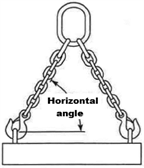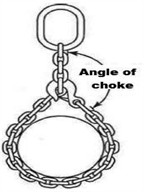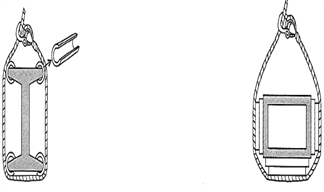(1) Only use chain slings that are made from grade 80 or higher alloy steel chain.
(2) The following requirements must be met if manufacturing your own chain slings:
(a) Have a design factor of 4;
(b) Meet the rated load requirements in subsection (9) of this section.
(3) Rate chain slings with the load capacity of the lowest rated component of the sling. For example, if you use fittings that are rated lower than the sling material itself, identify the sling with the lower rated capacity.
(4) Makeshift fittings, such as hooks or links formed from bolts, rods, or other parts are prohibited.
(5) All chain slings must have legible identification information attached to the sling which includes the following information:
(a) Name or trademark of the manufacturer;
(b) Grade;
(c) Nominal chain size;
(d) Number of legs;
(e) Rated loads for the vertical hitch and bridle hitch and the angle upon which it is based;
(f) Length (reach);
(g) Individual sling identification (e.g., serial numbers);
(h) Repairing agency, if the sling was ever repaired.
(6) Inspections.
(a) A qualified person must inspect chain slings before their initial use, according to Table 2, both:
(i) When the sling is new; and
(ii) Whenever a repair, alteration, or modification has been done.
(b) A qualified person must perform a visual inspection for damage, each day or shift the chain sling is used. Immediately remove from service any sling damaged beyond the criteria in Table 2.
(c) A qualified person must perform periodic inspections on chain slings according to Table 2.
(i) Each link and component must be examined individually, taking care to expose and examine all surfaces including the inner link surfaces.
(ii) Remove slings from use:
• If any of the conditions in Table 2 are found;
• When they have been exposed to temperatures above one thousand degrees Fahrenheit.
(d) A written record of the most recent periodic inspection must be kept, including the condition of the sling.
Note: | An external code mark on the sling is an acceptable means of recording the inspection as long as the code can be traced back to a record. |
Table 2
Chain Sling Inspection/Removal Criteria
Inspect alloy steel chain slings for the following conditions: | Perform inspections: | |||
• | Missing or illegible sling identification. | |||
• | Cracks or breaks. | |||
• | Excessive nicks, gouges, or wear beyond that allowed in Table 3, Minimum Allowable Thickness at Any Point on a Link. | • | At least once a year for slings in normal service, which means use within the rated load. | |
• | Stretched chain links or components. | • | At least once a quarter for slings in severe service, which involves abnormal operating conditions. | |
• | Bent, twisted or deformed chain links or components. | • | As recommended by a qualified person for slings in special service, which is anything other than normal or severe. | |
• | Evidence of heat damage. | |||
• | Excessive pitting or corrosion. | |||
• | Inability of chain or components to hinge (articulate) freely. | |||
• | Weld spatter. | |||
• | Hooks that have any of the following conditions: | |||
– | Any visibly apparent bend or twist from the plane of the unbent hook; | |||
– | Any distortion causing an increase in throat opening of 5%, not to exceed 1/4 inch, or as otherwise recommended by the manufacturer; | |||
– | Wear exceeding 10% of the original section dimension of the hook or its load pin, or as otherwise recommended by the manufacturer; | |||
– | A self-locking mechanism that does not lock (if applicable); | |||
– | Any latch that does not close the hook's throat (if applicable). | |||
• | Other visible damage that raises doubt about the safety of the sling. | |||
Table 3
Minimum Allowable Thickness at Any Point on a Link
Nominal chain or coupling link size | Minimum allowable thickness at any point on the link | ||
Inches | Millimeters | Inches | Millimeters |
7/32 | 5.5 | 0.189 | 4.80 |
9/32 | 7 | 0.239 | 6.07 |
5/16 | 8 | 0.273 | 6.93 |
3/8 | 10 | 0.342 | 8.69 |
1/2 | 13 | 0.443 | 11.26 |
5/8 | 16 | 0.546 | 13.87 |
3/4 | 20 | 0.687 | 17.45 |
7/8 | 22 | 0.750 | 19.05 |
1 | 26 | 0.887 | 22.53 |
1 1/4 | 32 | 1.091 | 27.71 |
(7) Repair, alterations, or modifications.
(a) You must repair chain slings as follows:
(i) Slings must only be repaired by the manufacturer or a qualified person;
(ii) Chain used for sling repair must be alloy steel chain manufactured and tested in accordance with ASTM A 391/A 391M for Grade 80 chain and ASTM A 973/A 973M for Grade 100 chain;
(iii) Components for alloy steel chain slings must be manufactured and tested in accordance with ASTM A 952/A 952M;
(iv) The use of mechanical coupling links within the body of a chain sling to connect two pieces of chain is prohibited;
(v) Replace cracked, broken, or bent chain links or components instead of repairing them.
(b) The sling must be marked to show the repairing agency.
(c) Repaired slings must be proof tested according to the requirements in subsection (8) of this section. If only replacing components of the sling, and the components were individually proof tested, the sling does not have to be tested as a whole.
Note: | For additional requirements relating to repair and modification see WAC 296-155-33705(9). |
(8) Proof test chain slings. Prior to initial use, all new and repaired chain and components of an alloy steel chain sling, either individually or as an assembly must be proof tested by the sling manufacturer or a qualified person. Follow the requirements in Table 4, Chain Sling Proof Load Requirements.
Table 4
Chain Sling Proof Load Requirements
When proof testing this type of equipment: | Then proof load: | |
• | Single or multiple leg slings. | Each leg and component to at least two times the single leg vertical hitch rated load. |
• | Components attached to single legs. | |
• | Master links for double leg bridle slings. | To at least 4 times the single leg vertical hitch rated load. |
• | Single basket slings. | |
• | Master coupling links connected to two legs. | |
• | Master links for triple and quadruple leg bridle slings. | To at least 6 times the single leg vertical hitch rated load. |
• | Double basket bridle sling. | |
(9) Chain slings rated loads, the term "working load limit" is commonly used to describe rated load.
Note: | Rated loads are based on the following factors: |
• Strength of sling materials; | |
• Design factor; | |
• Type of hitch; | |
• Angle of loading. |
(a) Chain slings must be used within the rated loads shown in Tables 1 through 4 of ASME B30.9-2010. For angles that are not shown in these tables, either use the rated load for the next lower angle or one calculated by a qualified person.
(b) The use of horizontal sling angles less than 30 degrees are prohibited, unless recommended by the sling manufacturer or a qualified person. See Figure 1, Multiple-Leg Bridle Sling Hitch.
(c) Rated loads must be verified for slings used in a choker meet the values shown in the above referenced tables provided that the angle of choke is 120 degrees or greater. See Figure 2, Single-Leg Choker Hitch.
(d) Rated loads for angles of choke less than 120 degrees must be determined by the manufacturer or a qualified person.
 |
Figure 1 Multiple-Leg Bridle Sling Hitch |
 |
Figure 2 Single-Leg Choker Hitch |
(10) Use of chain slings.
(a) You must shorten or adjust slings using only methods approved by the manufacturer or a qualified person.
(b) You must not shorten or lengthen slings by knotting or twisting.
(c) You must avoid twisting and kinking.
(d) You must hitch slings in a way that provides control of the load.
(e) You must balance the load in slings used in a basket hitch to prevent it from slipping.
(f) You must protect slings from sharp edges of the load. See Figure 3.
(g) You must prevent the sling from snagging anything during the lift, with or without load.
 |
Softeners can be made from split pipe, padding or blocking |
Figure 3 Softeners |